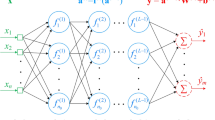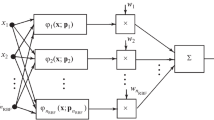Abstract
This paper combines the multilayer perceptron (MLP) and the radial basis function (RBF) neural networks to design a hybrid multilayer perceptron-radial basis function (HMLP-RBF) neural network for solving the hyperbolic conservation laws without the knowledge of analytical solutions. In HMLP-RBF, it first performs feature extraction on the input data through the MLP network layers with the hyperbolic tangent function as the activation function and then feeds the feature to the last hidden layer with the RBF as the activation function. It combines the advantages of the MLP network and the RBF, i.e., the excellent nonlinearity approximation ability of RBF and the feature of not being easy to trap in the local extremum of MLP network. Compared with the conventional MLP with the hyperbolic tangent function as the activation function, the single-layer perceptron-radial basis function (SLP-RBF) and the multilayer perceptron-radial basis function (MLP-RBF) models, the HMLP-RBF model requires fewer training epochs to achieve the same accuracy for solving the inviscid Burgers equation. When resolving the Riemann problems governed by the shallow water equations and the Euler equations, the results obtained by the HMLP-RBF neural network are better than other neural network models, especially in the vicinity of discontinuities.













Similar content being viewed by others
References
Saka B, Dağ İ. A numerical study of the Burgers’ equation. J Franklin Inst. 2008;345(4):328–48.
Hon YC, Mao XZ. An efficient numerical scheme for Burgers’ equation. Appl Math Comput. 1998;95(1):37–50.
García-Navarro P, Murillo J, Fernández-Pato J, Echeverribar I, Morales-Hernández M. The shallow water equations and their application to realistic cases. Environ Fluid Mech. 2019;19(5):1235–52.
Casulli V. Semi-implicit finite difference methods for the two-dimensional shallow water equations. J Comput Phys. 1990;86(1):56–74.
Jameson A, Baker T. Solution of the Euler equations for complex configurations. In: 6th computational fluid dynamics conference danvers. 1983: 1929.
Constantin P. On the Euler equations of incompressible fluids. Bull Am Math Soc. 2007;44(4):603–21.
Jagtap AD, Kumar R. Kinetic theory based multi-level adaptive finite difference WENO schemes for compressible Euler equations. Wave Motion. 2020;98: 102626.
Levy D, Puppo G, Russo G. Central WENO schemes for hyperbolic systems of conservation laws. ESAIM Math Modell Numer Anal. 1999;33(3):547–71.
Zhu J, Qiu J. A new type of finite volume WENO scheme for hyperbolic conservation laws. J Sci Comput. 2017;73(2):1338–59.
Harten A. High resolution schemes for hyperbolic conservation laws. J Comput Phys. 1997;135(2):260–78.
Wu XS, Zhao YX. A high-resolution hybrid scheme for hyperbolic conservation laws. Int J Numer Meth Fluids. 2015;78(3):162–87.
Shi J, Hu C, Shu CW. A technique of treating negative weights in WENO schemes. J Comput Phys. 2002;175(1):108–27.
Kurganov A, Petrova G. A third-order semi-discrete genuinely multidimensional central scheme for hyperbolic conservation laws and related problems. Numer Math. 2001;88(4):683–729.
Cai Z, Chen J, Liu M. Least-squares ReLU neural network (LSNN) method for scalar nonlinear hyperbolic conservation law[J]. Appl Numer Math. 2022;174:163–76.
Zhang X, Cheng T, Ju L. Implicit form neural network for learning scalar hyperbolic conservation laws. Math Sci Mach Learn PMLR. 2022;2022:1082–98.
Boso F, Tartakovsky DM. Data-informed method of distributions for hyperbolic conservation laws. SIAM J Sci Comput. 2020;42(1):A559–83.
Jagtap AD, Kharazmi E, Karniadakis GE. Conservative physics-informed neural networks on discrete domains for conservation laws: applications to forward and inverse problems. Comput Methods Appl Mech Eng. 2020;365: 113028.
Mao Z, Jagtap AD, Karniadakis GE. Physics-informed neural networks for high-speed flows. Comput Methods Appl Mech Eng. 2020;360: 112789.
Jacot A, Gabriel F, Hongler C. Neural tangent kernel: Convergence and generalization in neural networks. In: Advances in neural information processing systems, 2018, 31.
Sharma S, Sharma S, Athaiya A. Activation functions in neural networks. Towards Data Sci. 2017;6(12):310–6.
Pascanu R, Montufar G, Bengio Y. On the number of response regions of deep feed forward networks with piece-wise linear activations. ArXiv Preprint arXiv:1312.6098, 2013.
Agostinelli F, Hoffman M, Sadowski P, et al. Learning activation functions to improve deep neural networks. arXiv preprint arXiv:1412.6830, 2014.
Jiang Q, Zhu L, Shu C, Sekar V. An efficient multilayer RBF neural network and its application to regression problems. Neural Comput Appl. 2021;3:1–8.
Wu Y, Wang H, Zhang B, Du KL. Using radial basis function networks for function approximation and classification. Int Sch Res Not. 2012;2012:1–34.
Powell M. Radial basis function for multivariable approximations: a review. In: IMA conference on algorithms for the approximation of functions and data. Shrivenham, 1985. pp. 143–167.
Broomhead D, Lowe D. Multivariable functional interpolation and adaptive networks. Complex Syst. 1988;2:321–55.
Jackson IRH. Convergence properties of radial basis functions. Constr Approx. 1988;4(1):243–64.
Moody J, Darken C. Fast learning in networks of locally-tuned processing units. Neural Comput. 1989;1:281–94.
Brizzotti MM, Carvalho A. The influence of clustering techniques in the RBF networks generalization. Image Process Its Appl. 1999;1:87–92.
Wettschereck D, Thomas D. Improving the performance of radial basis function networks by learning center locations. Adv Neural Inf Process Syst. 1991;4:1133–40.
Cha I, Kassam SA. RBFN restoration of nonlinearly degraded images. IEEE Trans Image Process. 1996;5(6):964–75.
Mhaskar H, Liao Q, Poggio T. When and why are deep networks better than shallow ones? Proc AAAI Conf Artif Intell. 2017;31(1):2343–9.
Chao J, Hoshino M, Kitamura T, Masuda, T. A multilayer RBF network and its supervised learning.In: International joint conference on neural networks. Proceedings (Cat. No. 01CH37222). IEEE, 2001, vol. 3, pp. 1995–2000.
Jiang Q, Zhu L, Shu C, Sekar V. Multilayer perceptron neural network activated by adaptive Gaussian radial basis function and its application to predict lid-driven cavity flow. Acta Mech Sin. 2021;37:1757–72 (in press).
Govindarajan M, Chandrasekaran RM. Intrusion detection using neural based hybrid classification methods. Comput Netw. 2011;55(8):1662–71.
Hirahara M, Oka N. A hybrid model composed of a multilayer perceptron and a radial basis function network. In: Proceedings of 1993 international conference on neural networks (IJCNN-93-Nagoya, Japan). IEEE, 1993, vol. 2, pp. 1353–1356.
Eredics P, Dobrowiecki TP. Hybrid MLP-RBF model structure for short-term internal temperature prediction in greenhouse environments. In: 2013 IEEE 14th international symposium on computational intelligence and informatics (CINTI). IEEE, 2013, pp. 377–380.
Thompson ML, Kramer MA. Modelling chemical processes using prior knowledge and neural networks. Am Inst Chem Eng J. 1994;40:1328–40.
Li J, Cheng J, Shi J, Huang F. Brief introduction of back propagation (BP) neural network algorithm and its improvement. In: Advances in computer science and information engineering. Berlin: Springer; 2012. p. 553–8.
Shen X, Cheng X, Liang K. Deep Euler method: solving ODEs by approximating the local truncation error of the Euler method. arXiv preprint arXiv:2003.09573 (2020)
Weinan E, Yu B. The deep Ritz method: a deep learning-based numerical algorithm for solving variational problems. Commun Math Stat. 2018;6(1):1–12.
Sirignano J, Spiliopoulos K. DGM: A deep learning algorithm for solving partial differential equations. J Comput Phys. 2018;375:1339–64.
Acknowledgements
The research is partially supported by the National Natural Science Foundation of China (11871414, 12202191), Science Foundation Project of Hunan Excellent Youth (2019JJ30022), Natural Science Foundation of Hunan Province (20B574), Natural Science Foundation of Jiangsu Province (Grant No. BK20210273), the Priority Academic Program Development of Jiangsu Higher Education Institutions (PAPD), and the Fund of Prospective Layout of Scientific Research for NUAA (Nanjing University of Aeronautics and Astronautics).
Author information
Authors and Affiliations
Corresponding authors
Ethics declarations
Conflict of interest
On behalf of all authors, the corresponding author states that there is no conflict of interest.
Additional information
Publisher's Note
Springer Nature remains neutral with regard to jurisdictional claims in published maps and institutional affiliations.
Rights and permissions
Springer Nature or its licensor holds exclusive rights to this article under a publishing agreement with the author(s) or other rightsholder(s); author self-archiving of the accepted manuscript version of this article is solely governed by the terms of such publishing agreement and applicable law.
About this article
Cite this article
Xiao, Y., Yang, L., Yuan, H. et al. A Hybrid Multilayer Perceptron-Radial Basis Function (HMLP-RBF) Neural Network for Solving Hyperbolic Conservation Laws. SN COMPUT. SCI. 3, 490 (2022). https://doi.org/10.1007/s42979-022-01413-5
Received:
Accepted:
Published:
DOI: https://doi.org/10.1007/s42979-022-01413-5




